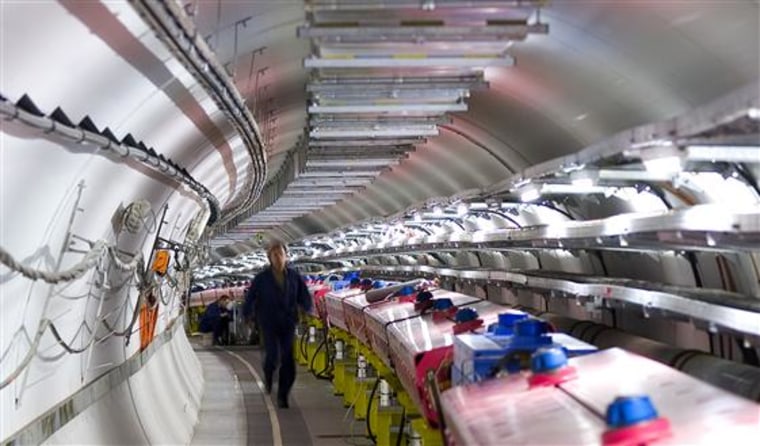Months after researchers reported that they measured neutrinos traveling faster than light, they're finding that the incredible result may have been due to a bad connection rather than a violation of Albert Einstein's special theory of relativity.
The potential instrumental glitches, first reported by ScienceInsider's Edwin Cartlidge, is addressed in a statement from the OPERA Collaboration, the group behind the controversial neutrino-beam experiments.
Last year, the OPERA team made ultra-precise measurements of how long it took for neutrinos to make the 450-mile (732-kilometer) trip between the CERN particle physics lab on the French-Swiss border and Italy's Gran Sasso National Laboratory. When they took the speed of light and a wide variety of other experimental factors into consideration, they determined that the neutrinos arrived 60 nanoseconds before they should have.
If the results were to stand up, they'd mark the first failed test for Einstein's century-old theory. That's one reason why researchers found them so hard to believe, even though a repetition of the experiment yielded the same results. The OPERA team has been reviewing the entire experiment, and several other research groups have been trying to replicate it. A key concern has been the Global Positioning Satellite system used to clock the neutrinos' transit time. The measurements are required to be so precise that the relativistic effects of Earth's gravitational field on the GPS system had to be taken into account.
Now sources familiar with the OPERA review say scientists have identified two potential problems with the experimental apparatus. One has to do with a fiber-optic connector that sends a GPS time stamp to the experiment's master clock. That connector may not have been functioning correctly when the neutrino-timing measurements were made, and as a result, the recorded flight time would be shorter than the actual time. That alone could explain the seemingly faster-than-light results.
Another potential problem has to do with the oscillator that was used to generate the time stamps for GPS synchronization. This problem could have made the flight time look longer than it really was.
The sources I contacted via email declined to be identified because they weren't authorized to speak in advance of the statement issued Thursday. One of the scientists said the glitches should not be characterized as "errors," but instead as "nasty instrumental effects."
CERN spokesman James Gillies confirmed that the GPS connector problem was being investigated, but he emphasized that the effects still had to be confirmed. "More beam will be needed before we know for sure," he told me in an email. Tests with short pulsed beams have been scheduled for May.
Update for 9 a.m. ET Feb. 23: CERN has issued the expected statement about the potential glitches:
"The OPERA collaboration has informed its funding agencies and host laboratories that it has identified two possible effects that could have an influence on its neutrino timing measurement. These both require further tests with a short pulsed beam. If confirmed, one would increase the size of the measured effect, the other would diminish it. The first possible effect concerns an oscillator used to provide the time stamps for GPS synchronizations. It could have led to an overestimate of the neutrino's time of flight. The second concerns the optical fibre connector that brings the external GPS signal to the OPERA master clock, which may not have been functioning correctly when the measurements were taken. If this is the case, it could have led to an underestimate of the time of flight of the neutrinos. The potential extent of these two effects is being studied by the OPERA collaboration. New measurements with short pulsed beams are scheduled for May."
Update for 1:53 p.m. ET Feb. 23: Here's a similar statement from Italy's nuclear research institute, INFN:
"The OPERA Collaboration, by continuing its campaign of verifications on the neutrino velocity measurement, has identified two issues that could significantly affect the reported result. The first one is linked to the oscillator used to produce the event's time-stamps in between the GPS synchronizations. The second point is related to the connection of the optical fiber bringing the external GPS signal to the OPERA master clock.
"These two issues can modify the neutrino time of flight in opposite directions. While continuing our investigations, in order to unambiguously quantify the effect on the observed result, the Collaboration is looking forward to performing a new measurement of the neutrino velocity as soon as a new bunched beam will be available in 2012. An extensive report on the above mentioned verifications and results will be shortly made available to the scientific committees and agencies."
More about those pesky neutrinos:
- Faster-than-light neutrinos pass test
- Neutrinos spark wild scientific leaps
- Faster-than-light neutrinos? Not so fast, some say
- Challenging Einstein is usually a losing venture
- Interactive: Putting Einstein to the test
- 'Virtually Speaking Science': Podcast on weird physics
Connect with the Cosmic Log community by "liking" the log's Facebook page, following @b0yle on Twitter or following the Cosmic Log Google+ page. You can also check out "The Case for Pluto," my book about the controversial dwarf planet and the search for new worlds.
